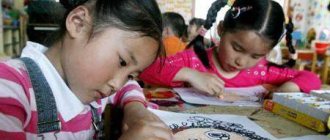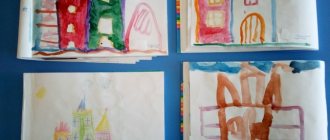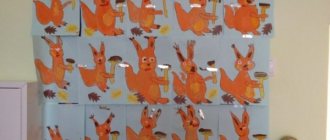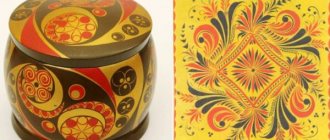The topic “My Family” is on the list of mandatory ones in fine arts training programs in kindergartens and schools. According to psychologists, by drawing a portrait of a family, a child involuntarily reveals his inner world, experiences and emotions. By analyzing children's drawings, you can understand how a little person perceives his family and himself in it, whether the child is comfortable, whether he trusts his parents, and whether there are problems in relationships. Possible interpretations of children's drawings on the theme “Family”, as well as step-by-step instructions for drawing a family with pencil and paints, are in our article.
Abstract of OOD on drawing in the preparatory group “My Home”
Lyubov Kuznetsova
Summary of OOD on drawing in the preparatory group “My Home”
Software tasks. Continue to develop the ability to perceive the color richness of the surrounding world and the desire to convey it in drawing. Develop the ability to search for graphic images based on observations. Strengthen the ability to actively apply previously developed methods of drawing houses of different heights and sizes. Develop conversational speech, participate in composing a story based on a drawing.
Material: Slides. page illustrations, crayons, pencils.
Preliminary work: examination of illustrations, photographs on the topic “Home”
.
Games with the constructor “Building a house”
.
Educator Game: “Pass the ball, say your street and house number”
Attention, attention, I invite you on a tour through the streets of our native village. ( Illustrations of houses and sights of the village are posted group
What kind of houses are there on the streets of our village? What is the difference? What parts does the house consist of? What do you think is the most important thing in a home?
Yes, every house, yours and others, has a roof, windows, doors, and a balcony. Now I invite you to play a game called “In order to”
. I will say the beginning of the sentence, and you will finish it.
— A house needs a roof in order to...
— The house needs doors in order to...
— The house needs windows in order to...
— The house needs a porch in order to...
— The house needs a pipe in order to...
Children answer, fantasize, and sometimes give different answers.
(The slide show accompanies the guys’ answer)
Educator: Of course, houses are very different: high and low, big and small, old and new, with large windows and small, with a triangular roof and a flat one; Every house is good in its own way, for everyone their own home is the best and dearest, because:
My relatives live there,
I can't live a day without her.
I strive for it always and everywhere,
I won’t forget the way to him.
I can hardly breathe without him,
My home, dear, is warm. (House)
So each of you has a house where you live with your family. It is probably warm, cozy, beautiful.
— Guys, I suggest you draw the house in which you live. But first, each of you will be a tour guide in your own home. Try drawing a verbal portrait of your home so we can introduce it. It was very interesting for us to listen to the description of your houses. Now, I think you can draw your favorite house .
One two three four five. (Children do jumping in place)
Let's build and play.
We are building a big, tall house. (Stand on tiptoes and stretch arms up)
What a beautiful house! (They extend their arms forward with an index gesture)
An old gnome will live in it. (Squat)
(Independent creative activity of children)
.
— Guys, I suggest you look at your drawings. We've got a whole street. Children, did you like your drawings? And I really liked it. You all worked really hard today. What did you enjoy doing most today?
Abstract of the educational activity in the preparatory group “My favorite city of Pyatigorsk” Abstract of the educational activity in the preparatory group on the topic: “My favorite city of Pyatigorsk” Integration of educational areas: “Cognitive development”.
GCD summary for speech development in the preparatory group “My Home, My Family” GCD summary for speech development in the preparatory group on the topic “My Home, My Family” Goal: To consolidate children’s understanding of family members.
Notes on drawing “My favorite fairy-tale hero” in the preparatory group Theme. "My favorite fairy-tale hero." Drawing with pencils. Tasks. Teach children to convey in drawing images of fairy tales, the characteristic features of their favorite one.
Abstract of the OOD on artistic and aesthetic activities in drawing in the preparatory group “Winter Sorceress” Program content: 1. Strengthen children’s ability to convey the colors of winter in a drawing, arrange the image across the entire sheet. 2. Develop.
Abstract of the OOD on drawing “Thumbelina” in the preparatory group for school Abstract of the OOD on drawing “Thumbelina” in the preparatory group for school Goal: to continue to develop the ability to reflect characteristic features in drawing. OOD abstract on drawing “My mother is a queen!” in the preparatory group OOD notes on drawing “My mother is a queen!” in the preparatory group Goal: to consolidate children’s knowledge about the portrait genre. Objectives: Educational:.
Summary of OOD in the preparatory group. Reading the work of S. Ya. Marshak “Cat’s House” Program objectives: Continue to introduce the works of writers, Develop interest in fiction; Improve your speech.
Abstract of OOD on design “What does it cost us to build a house” in the preparatory group SYNOPSIS OF ORGANIZED EDUCATIONAL ACTIVITY IN THE EDUCATIONAL FIELD: “ARTISTIC AND AESTHETIC DEVELOPMENT” Preparatory.
OOD on cognitive development “The House in which I live” in the preparatory group. Goal: to cultivate a caring attitude towards surrounding objects; consolidate ideas about the premises in the apartment. Preparatory work:.
Abstract of the educational activity in the preparatory group “Beloved Tyumen - my native city” Abstract of the educational activity in the preparatory group. TEACHER Stepanchuk L.P. “Beloved Tyumen - my native city” Program objectives: 1. Educational:.
Source
Family coat of arms - what is it and how to draw?
Often in elementary school, children make a family coat of arms as homework. It is a kind of shield (you can choose and edit the shape yourself), which depicts the main values of your family in the form of objects, words or phenomena.
To paint such a picture, you need to talk with your family and highlight the main preferences, functions or features of your family. For example, the coat of arms can depict love, care, support and happiness. You can come up with many different variations of the image of the coat of arms.
For the painting you will need:
- Paper;
- A simple pencil and eraser;
- Colored pencils or paints, felt-tip pens, etc.;
Start with the shape - it can be either in the form of well-known standard shapes (square, circle, triangle, rectangle, oval), or in the form of unusual objects, such as a cloud, sun or heart. Divide the entire interior of the coat of arms into several “divisions.” These boxes will contain your chosen family values.
After the black and white pencil drawing, you can use paints or colored pencils. Sometimes the coat of arms is decorated with additional details - ribbons, flowers, etc.
Notes on drawing in the preparatory group on the topic “My Family.”
Svetlana Ignatova
Notes on drawing in the preparatory group on the topic “My Family.”
MKDOU CRR "Kindergarten No. 3"
Voronezh region, Novaya Usman.
Summary of a drawing lesson in the preparatory group “My Family ”
Author: Svetlana Vladimirovna Ignatova, additional education teacher.
1. Learn to arrange images on a sheet in accordance with the content of the picture.
2. Strengthen the ability to draw a human figure , convey the relative size of a child and an adult.
3. Practice drawing an outline with a simple pencil and then coloring it in with colored pencils. Learn independently in choosing a plot and execution technique.
4. Develop creativity and imagination. Develop the ability to see the beauty of the created image.
5. Foster a sense of respect for older family .
Material: White A4 paper, frame template, colored pencils.
Reproductions of artists' works depicting a family .
Materials for painting
Before you start drawing, you need to decide what the image will be on and how it will be applied. Of all the surfaces for drawing, plain paper is considered the most convenient and versatile. It is easy to draw on it with all pencils and paints, like watercolors or gouache.
You can complicate the task a little and choose a canvas. But for such an item you need to stock up on special oil paints and brushes.
GCD move.
I really love it when everyone gets together,
The table is covered with a white tablecloth.
Grandma and mom, dad and me
We are called together ( family )
.
The topic of our lesson will be “My family ”
.
What is family ? (Children's answers)
.
Educator: A family is a home , the most precious thing that every person has is the people who live together: mother, father, grandmother, grandfather, sister, brother. Relatives whom we love, from whom we take example, whom we care about and whom we wish goodness and happiness.
The family has been revered since ancient times and people have created many proverbs:
— "My home is my castle"
.
— “What is the treasure for if there is harmony in the family ”
.
— "Being a guest is good, but being at home is better"
.
— “It’s warm in the sun, good in mother’s presence”
.
— “Wormwood cannot grow without a root”
.
Didactic game “Pick up the signs”
- What are they like, people dear and dear to us?
Choose as many words as possible that tell about mom, dad, grandfather, grandmother, etc.
Finger gymnastics (friendly family )
– bent fist, alternately extending fingers.
This finger is grandpa
This finger is grandma
This finger is daddy
This finger is mommy
But this finger is me
Creating a drawing (step by step)
- First of all, let the child, under your guidance, draw his father. A baby is depicted on the shoulders of the head of the family.
- Circles are ideal for sketches of faces; bodies are represented as rectangular figures. To recreate the arms and legs, start by drawing a straight line;
- Pay attention to drawing dad's face. Add expressiveness to the outline, draw hair and ears. Using the same analogy, we get the head of a child;
- The boy's figure should include: neck, shoulders, arms and torso. Clothing can be for summer or for other seasons;
- Draw clothes for the members of the picture. All first drawings are carefully erased with an eraser. What is clothing without jewelry?
- Draw buttons, rivets, watches and other elements;
- Faces will look better if they include eyes, nose, eyebrows and mouth.
- Let the child remember the individual characteristics of relatives.
- These could be: dimples, beard or moles;
- Draw the figures of mother and daughter next to father and son;
- They must also be dressed and must have decorations: bags, backpacks, flowers;
- The contours that were previously used should be removed.
- When you are satisfied with the black and white result, proceed to coloring the product with paints.
Before this instruction, children and their parents were interested in the question of how to beautifully draw a family portrait. Now the answer is clear, you need to pay attention to the diagrams and proposed actions.
Thus, the family archive will be enriched with new works. It became extremely clear how to simply draw and put meaning into the canvas.
The main thing is that the picture has meaning and is not painted to please parents. A child is able to develop perseverance and imagination during the creative process.
Applications
The next option, which is suitable for older children, is to use appliqués to depict your family. For example, using colored paper, cardboard, glue and scissors. In truth, it is precisely this kind of “drawing” in a preschool educational institution (“My family” is its theme) that causes great delight in children. After all, this is how a child not only learns to portray his family, but also develops fine motor skills.
Make sure that each child also has glue, scissors, cardboard and colored paper. Maybe the kids will want to choose exactly this method of depicting reality. You shouldn't stop them from doing this. Yes, this is not direct drawing on paper, but this method also corresponds quite well to the goals and objectives set. The child will still portray his family, albeit in a somewhat non-standard form.
Plasticine
Perhaps the most interesting approach to conducting our lesson today will be the use of plasticine and cardboard. With the help of these “devices”, oddly enough, you can also draw.
How? Let your child draw a drawing of his family using a pencil on cardboard. But he will color it with plasticine heated in his hands. This kind of drawing in preschool educational institutions (“My family” is the chosen topic) is often used in junior and middle groups. An interesting technique, but not all educators approve of it. And in vain.
The point is that this particular version of drawing can attract even the restless person. After all, a drawing painted with plasticine is so much fun! The child’s interest should be the main component of the lesson. Let the children choose how they want to draw. If there are any difficulties, help the students. But remember - they must create themselves. And color your drawings too.




